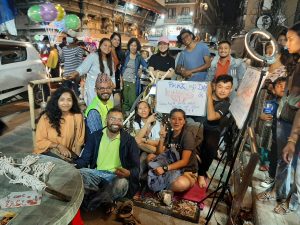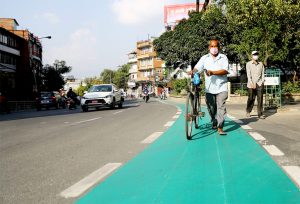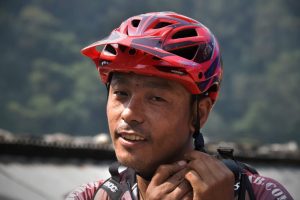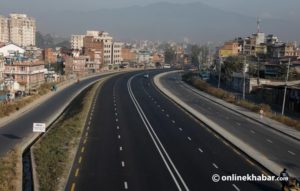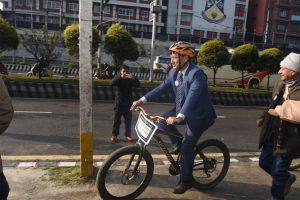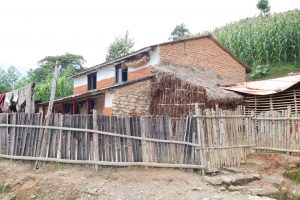Kathmandu offers every mountain biker bountiful to explore outdoors—intimate hills, lush woods, laidback countryside, a breath of fresh air, and by far, nature at its best. No sooner you are done with one fascinating jaunt than another awaits you. It’s all yours for the taking. All you got to do is make your mind up, prep up your bike, and hop onto your saddle.

The past two months of December 2019 and January 2020, with cold spells followed by dull overcast skies, erratic showers, and no sun for days, had dampened my mountain biking spirit close to naught. The first week of February showed a little promise, though.
Warmer and sunny days nudged me awake to dust my mountain bike and muse over some locales to ride. It also seemed long-overdue to stretch out my slackened muscles. I had heard a lot about the Kalu Pandey Hills among bikers for the track’s challenging inclines. I asked my neighbourhood cycling partner, Shayeet, if he would be interested in riding to those hills. He jumped at the offer.
Off to the hills
On a weekday, we left for Kalu Pandey. The early morning sun seemed to promise crisp weather. “Great weather,” Shayeet remarked as we jumped on to our saddles. We hit the Ring Road and headed for Sitapaila. Since I was a little confused about the route, I had called earlier an old pro-biker friend who had biked there several times. He suggested we took the Sitapaila—Ramkot route.

Oversight
After something like one-half kilometre westward after Sitapaila, it turned out, we had, unwittingly, taken a wrong turn at a fork. Instead of heading straight to Ramkot, we took the road on our right towards the Druk Amitabh Mountain Monastery, otherwise known as Seto Gumba (white monastery).
Without going uphill to the monastery, we headed further north to Ichangu Narayan. The paved road turned into a stiff climb and led towards wooded heights flanked by Nagarjun hills. Jamacho, with its dense, lush forest, towered high on our right. I still thought we were on the right track. We were not.

Not until we pedalled past the Ichangu Narayan Vishnu Temple and climbed a hill leaving behind a bazaar area and clusters of houses than I had the hunch that we had taken the wrong route. “Shayeet, we better ask some locals, or else we will get lost,” I called out.
We stopped by a house and approached a local guy. We had indeed taken a circuitous route. The guy told us we needed to climb the hill ahead and turn south towards Seto Gumba, then take the downhill dirt road to Ramkot. We had just done a steep climb, now another awaited. “Darn it,” Shayeet called out in frustration. Some 45 minutes later, we met a side track, one went down west, while the other headed east towards Seto Gumba.

We stopped by a teashop and asked the shop owner. “Head down along that wooded hill,” he pointed a finger a little to the south and said, “and just stick to the dirt road; that will take you straight off to Ramkot. After that, there would be no mistaking the road to Kalu Pandey. Just ask around.”

Countryside
The height rolled out a view of Ramkot, a sprawling cluster of houses at the foothill. I could make out from the height the road that cut right across sprawling fields and the countryside from Sitapaila and could even locate the turnoff where we had screwed up.

The ridge we were on seemed to burst into colours as clumps of golden marigold dotted the hillside, lending a pleasant setting to the rural landscape. They could not be wild, could they, I asked myself? The locals around the place must be into marigold farming, I mused. On the other hand, haze and smog seemed to cloak the far-off suburbs like a veil—a depressing sight indeed.
Ramkot
The gravelly downhill section proved a real thrill as we coasted down the winding track, across quiet woods, with soaring pine trees. It made us forget the long hard climb we just did. It hardly took us 20 minutes to reach Dandapauwa and another 10 minutes to Ramkot Bazaar.

It was past one in the afternoon, and we were starving. Our lunch included, as it often did on our rides, our favourite dal-bhat. The food, contrary to the lady owner’s heaping praise on it, tasted bland. But we ate our fill as we were hungry. At least, the carb from dal-bhat would help on the gruelling incline that followed next.
After a half-hour time-out, we hit the road again and headed southwest in the direction of Kalu Pandey Hills. It suddenly struck me a slight detour to Bhim Dunga would not be a bad idea and take not very long. So, we took the turn-off to our right.
Detour
I had heard a lot about the stiff climbs to Kalu Pandey. But the one-half kilometre to Bhim Dunga turned out the ‘mother of all uphills’ and a mountain biker’s worst nightmare. Even Shayeet, who considered himself a tough uphiller, had to get off his bike and push. For me, even shoving my bike on that gradient seemed punishing, let alone riding.

After sweating it out for almost 25 minutes on the incline, the sight of the crest came as a welcome respite. That was the second ridge we had scaled that day.

Not ‘Bhim Dhunga’
A little away from habitation, the ridge bore a large stone altar with three gajurs (pinnacles) built on the raised ground. It gave the impression of a midget temple. The front of the stonework included two deities, one was the Ganesh hands down, but I could not place the other chiselled form as it was little disfigured, which stood with one arm holding what looked like a Gada (mace).
As I still wondered about the deity, an elderly fellow arrived on the scene and said the figure belonged to Bhimsen. To my great delight, he also threw light upon the history of the place. “Everyone seems to call this place ‘Bhim Dhunga’, but the actual name happens to be ‘Bhim Dunga’, dunga for a boat,” he explained and gave an account of the ancient folklore.

As the legend goes, Bhimsen of Mahabharat fame in days of Kali Yuga (3,102 BC) once happened to visit the ridge, which served as a ledge above a huge lake, said to be present Kathmandu Valley. Spellbound, he wished to explore the waters. He sent for a boat and took a ride. “That is said to have named the place Bhim Dunga,” he summed up. The grueling ride to Bhim Dunga, after all, turned out well worth a visit.
After a brief breather, we struck northeast towards Kalu Pandey. I had the feeling we would be doing another formidable climb as the forthcoming destination was higher than Bhim Dunga. My instinct came right. Hardly had we finished a downhill section, the road that branched out to Kalu Pandey took on a steep climb. The only upside to it was its paved sections.

Some 45 minutes struggling on the long steep climb, we arrived at a flatter section. The place turned out to be Switzerland Park, lately a popular getaway. We stopped for tea at a shop next to the park. The fellow-owner graciously cast light upon how the place came to be called by that name, which sounded nothing but out of place.
The story went like that. About a decade ago, when there were no roads, only walking trails to the hills of Dahachok, a group of Swiss backpackers happened to hike there with a guide, a local from the village. The hills then held pristine locales—untouched, rarely explored, free of pollution, and miles away from the chaos of the metropolis.

“Sheer bliss,” uttered one of the Swiss backpackers, impressed. “This place reminds me of my own country back home,” he told the guide. The guide, at social gatherings or when dropping by the local teashops to chat with friends and co-villagers, often waxed eloquent on that incident. Soon, word got around in pigeon circle in the small village.
The local villagers began calling the place Switzerland Danda (hill), wooing every hiker that went by. A few years later, someone from the village came up with the idea of turning it into a park. “In recent years, the park has become a popular picnic venue for Kathmandu people. If you come here on weekends, the park virtually turns into a carnival with loudspeakers belting out blaring music heard miles away,” he said with a grin.
We entered the park and took a fleeting look around. Much to our dismay, the place stank, and the ugly tin-roofed shelters looked hideous—only serving as a blot on the landscape. Piles of trash littered the sides into the bargain. Disappointed, we left for our final destination of the day, Kalu Pandey Memorial Park, hoping it would not let us down.
Images, except other sources mentioned in captions, by the author




